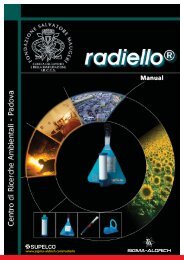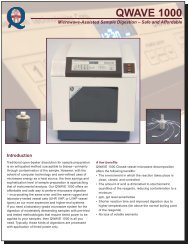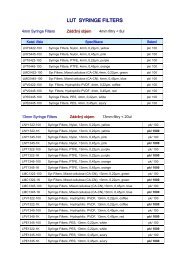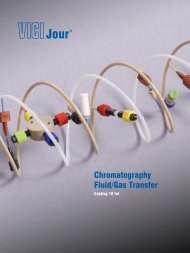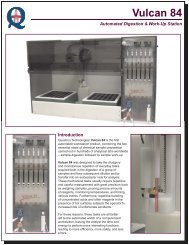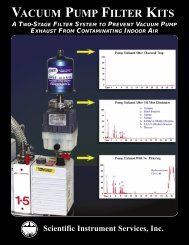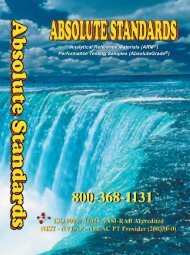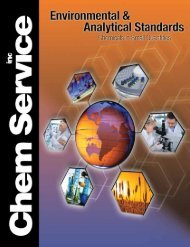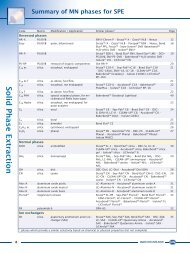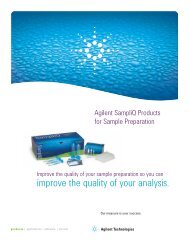Ascentis Express HPLC Columns with Fused-Core Technology ...
Ascentis Express HPLC Columns with Fused-Core Technology ...
Ascentis Express HPLC Columns with Fused-Core Technology ...
You also want an ePaper? Increase the reach of your titles
YUMPU automatically turns print PDFs into web optimized ePapers that Google loves.
Shown in Figure 13 is the separation of six tricyclic<br />
antidepressants (TCAs). The separation of these closely<br />
related compounds was performed under isocratic mobile<br />
phase conditions <strong>with</strong> mass spectrometric (MS) detection.<br />
Baseline resolution was achieved <strong>with</strong> a total separation<br />
time of 3 minutes demonstrating not only the potential<br />
speed of the <strong>Ascentis</strong> <strong>Express</strong> columns but also the<br />
resolving power. Note the MS compatible mobile phase<br />
and flow rate. Furthermore, the use of 2.1 mm I.D. columns<br />
provides a reduction in solvent consumption compared to<br />
typical flow rates for 4.6 mm I.D. or monolithic columns.<br />
Data in Figure 14 further illustrates the speed in which<br />
closely related compounds can be resolved using the<br />
<strong>Fused</strong>-<strong>Core</strong> particle. In this example, four -blockers are<br />
resolved in less than one minute under isocratic conditions<br />
utilizing MS detection. While a 10 cm column was utilized<br />
for the TCAs separation, a 5 cm column was used for the<br />
-blockers example.<br />
The separation of three steroids as well as a related<br />
impurity and degradant is shown in Figure 15. A high<br />
mobile phase flow rate of 0.6 mL/min was utilized and is<br />
suitable for <strong>Ascentis</strong> <strong>Express</strong> columns due to the Van<br />
Deemter curve associated <strong>with</strong> these columns. Isocratic<br />
mobile phase conditions were utilized as well as UV<br />
detection at 200 nm, a common detection wavelength<br />
for impurity profiling. Again, baseline resolution was<br />
achieved for all compounds <strong>with</strong> a total runtime of less<br />
than two minutes. It should be noted that the isocratic<br />
conditions used in these examples further enhances<br />
sample throughput versus gradient conditions due to no<br />
need for column re-equilibration. With a backpressure of<br />
just 4500 psi, this analysis could be performed on almost<br />
any <strong>HPLC</strong> system. A similar separation was attempted<br />
using a sub-2 μm particle column but was not possible<br />
given the same instrument constraints put on the<br />
<strong>Ascentis</strong> <strong>Express</strong> column.<br />
Figure 14. -Blockers on <strong>Ascentis</strong> <strong>Express</strong><br />
column: <strong>Ascentis</strong> <strong>Express</strong> C18, 5 cm x 2.1 mm ID (53822-U)<br />
instrument: Agilent 1100<br />
mobile phase A: 0.1% acetic acid in water<br />
mobile phase B: 0.1% acetic acid in acetonitrile<br />
mobile phase ratios: A:B = 74:26<br />
flow rate: 0.2 mL/min<br />
temp.: 35 °C<br />
det.: ABI 3200 QT; ESI(+), MS/MS<br />
injection: 1 μL<br />
1. Atenolol<br />
2. Pindolol<br />
3. Timolol<br />
4. Metoprolol<br />
Figure 15. Steroids on <strong>Ascentis</strong> <strong>Express</strong><br />
column: <strong>Ascentis</strong> <strong>Express</strong> C18, 10 cm x 2.1 mm ID (53823-U)<br />
instrument: Jasco X-LC<br />
mobile phase: 55:45 water:acetonitrile<br />
flow rate: 0.6 mL/min<br />
temp.: ambient<br />
det.: 200 nm<br />
injection: 1 μL<br />
1. Estriol<br />
2. -Estradiol<br />
3. Impurity<br />
4. Estrone<br />
5. Estrone degradant<br />
2<br />
1<br />
2<br />
4<br />
3<br />
1<br />
4<br />
3<br />
5<br />
G004063<br />
G004064<br />
technical service: 800-359-3041 (US and Canada only) / 814-359-3041<br />
13



